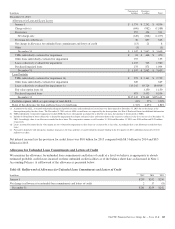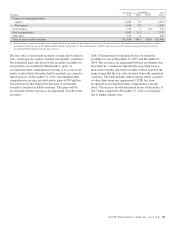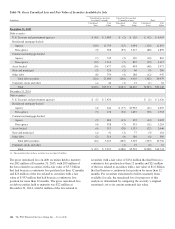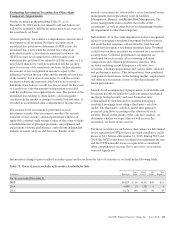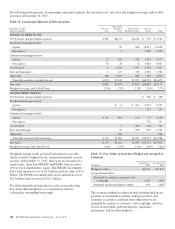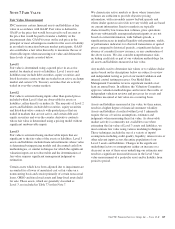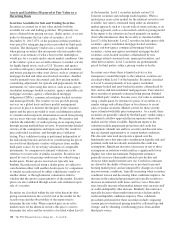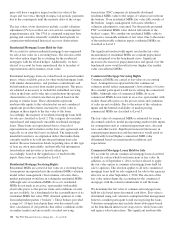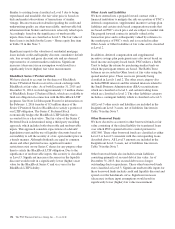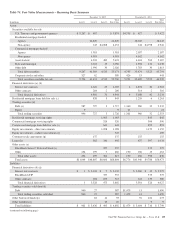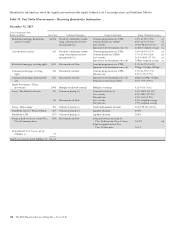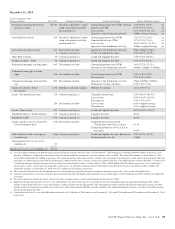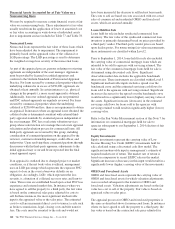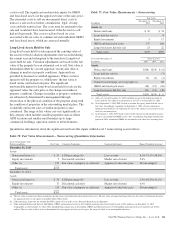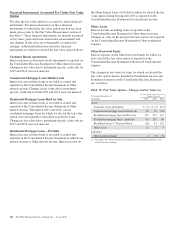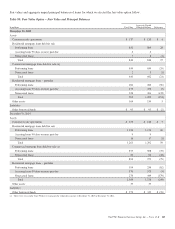PNC Bank 2015 Annual Report Download - page 171
Download and view the complete annual report
Please find page 171 of the 2015 PNC Bank annual report below. You can navigate through the pages in the report by either clicking on the pages listed below, or by using the keyword search tool below to find specific information within the annual report.inputs are management’s assumption of the spread applied to
the benchmark rate and the estimated servicing cash flows for
loans sold to the agencies with servicing retained. The spread
over the benchmark curve includes management’s
assumptions of the impact of credit and liquidity risk.
Significant increases (decreases) in the spread applied to the
benchmark would result in a significantly lower (higher) asset
value. The wide range of the spread over the benchmark curve
is due to the varying risk and underlying property
characteristics within our portfolio. Significant increases
(decreases) in the estimated servicing cash flows would result
in significantly higher (lower) asset value. Based on the
significance of unobservable inputs, we classified this
portfolio as Level 3.
Equity Investments – Direct Investments
The valuation of direct and indirect private equity investments
requires significant management judgment due to the absence
of quoted market prices, inherent lack of liquidity and the
long-term nature of such investments. The carrying values of
direct and affiliated partnership interests reflect the expected
exit price and are based on various techniques including
multiples of adjusted earnings of the entity, independent
appraisals, anticipated financing and sale transactions with
third parties, or the pricing used to value the entity in a recent
financing transaction. A multiple of adjusted earnings
calculation is the valuation technique utilized most frequently
and the multiple of earnings is the primary and most
significant unobservable input used in such calculation. The
multiple of earnings is utilized in conjunction with portfolio
company financial results and our ownership interest in
portfolio company securities to determine PNC’s interest in
the enterprise value of the portfolio company. Significant
decreases (increases) in the multiple of earnings could result
in a significantly lower (higher) fair value measurement. The
magnitude of the change in fair value is dependent on the
significance of the change in the multiple of earnings and the
significance of portfolio company adjusted earnings.
Valuation inputs or analysis are supported by portfolio
company or market documentation. Due to the size, private
and unique nature of each portfolio company, lack of liquidity
and the long-term nature of investments, relevant
benchmarking is not always feasible. A valuation committee
reviews the portfolio company valuations on a quarterly basis
and oversight is provided by senior management of the
business. These investments are classified as Level 3.
Unfunded commitments related to direct investments totaled
$23 million and $28 million at December 31, 2015 and
December 31, 2014, respectively. Outstanding contractual
obligations to existing direct investments totaled $11 million
and $9 million at December 31, 2015 and December 31, 2014,
respectively. During 2015, $5 million of financial support was
provided to existing direct investments compared to $39
million during 2014.
Equity Investments – Indirect Investments
We value indirect investments in private equity funds based
on net asset value (NAV) as provided in the financial
statements that we receive from their managers. Due to the
time lag in our receipt of the financial information and based
on a review of investments and valuation techniques applied,
adjustments to the manager-provided value are made when
available recent portfolio company information or market
information indicates a significant change in value from that
provided by the manager of the fund. In accordance with ASC
820-10, these investments are not classified in the fair value
hierarchy.
These indirect investments are not redeemable, however PNC
receives distributions over the life of the partnerships from
liquidation of the underlying investments by the investee,
which we expect to occur over the next twelve years. The
forced sale or restructuring of these investments would likely
result in PNC receiving less value than it would otherwise
have received in the ordinary course of business. Unfunded
commitments related to indirect investments totaled $103
million and $112 million at of December 31, 2015 and
December 31, 2014, respectively. During 2015, $17 million of
financial support was provided to indirect investments to
satisfy capital calls for commitments. The comparable amount
was $24 million during 2014.
Customer Resale Agreements
We have elected to account for structured resale agreements,
which are economically hedged using free-standing financial
derivatives, at fair value. The fair value for structured resale
agreements is determined using a model that includes
observable market data such as interest rates as inputs.
Readily observable market inputs to this model can be
validated to external sources, including yield curves, implied
volatility or other market-related data. These instruments are
classified as Level 2.
Loans
Loans accounted for at fair value consist primarily of
residential mortgage loans. These loans are generally valued
similarly to residential mortgage loans held for sale and are
classified as Level 2. However, similar to residential mortgage
loans held for sale, if these loans are repurchased and
unsalable, they are classified as Level 3. In addition,
repurchased VA loans, where only a portion of the principal
will be reimbursed, are classified as Level 3. The fair value is
determined using a discounted cash flow calculation based on
our historical loss rate. Due to the unobservable nature of this
pool level approach, these loans are classified as Level 3.
Additionally, we have elected to account for certain home
equity lines of credit at fair value. These loans are classified as
Level 3. This category also includes repurchased brokered
home equity loans. These loans are repurchased due to a
breach of representations or warranties in the loan sales
agreement and occur typically after the loan is in default.
The PNC Financial Services Group, Inc. – Form 10-K 153


